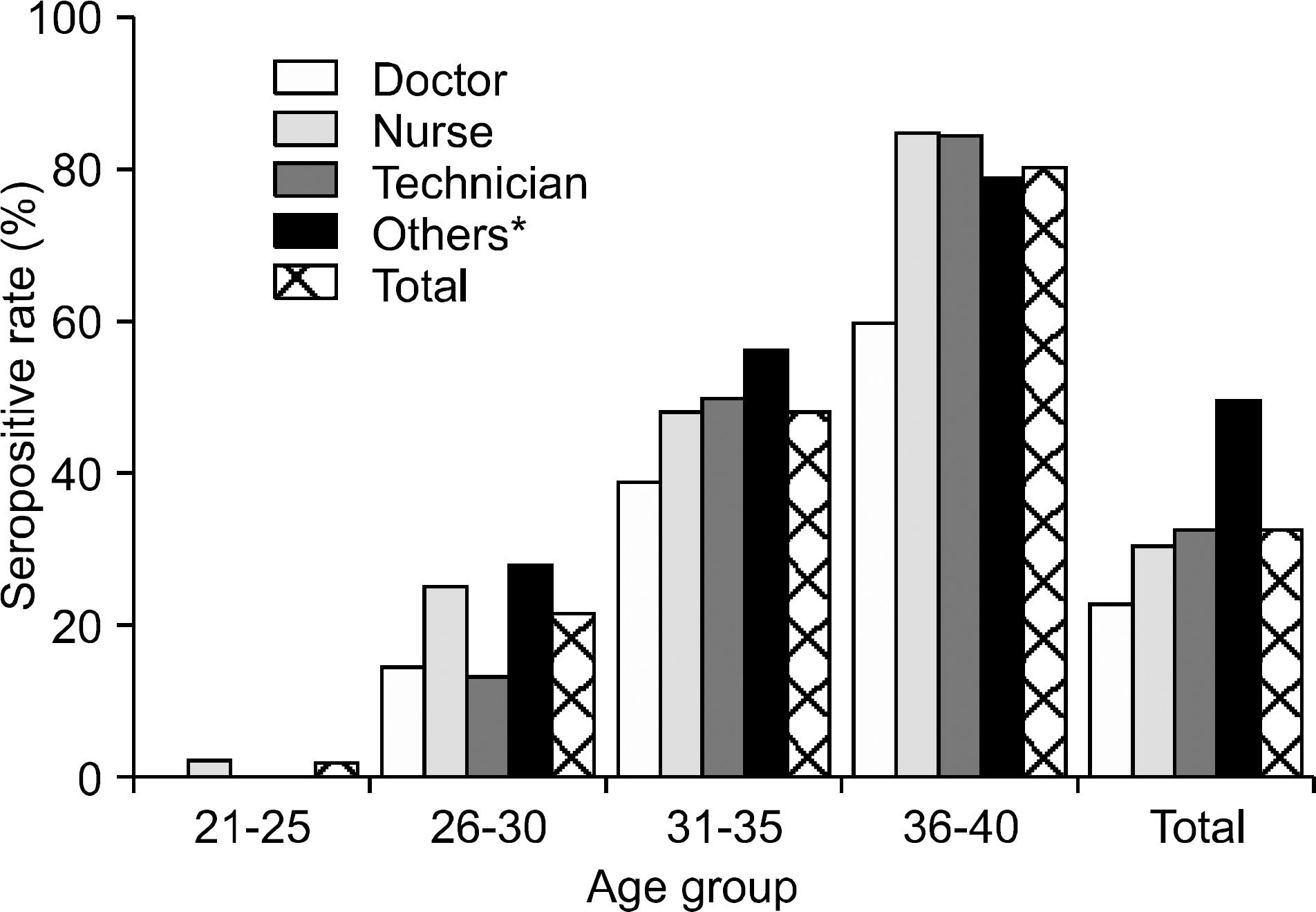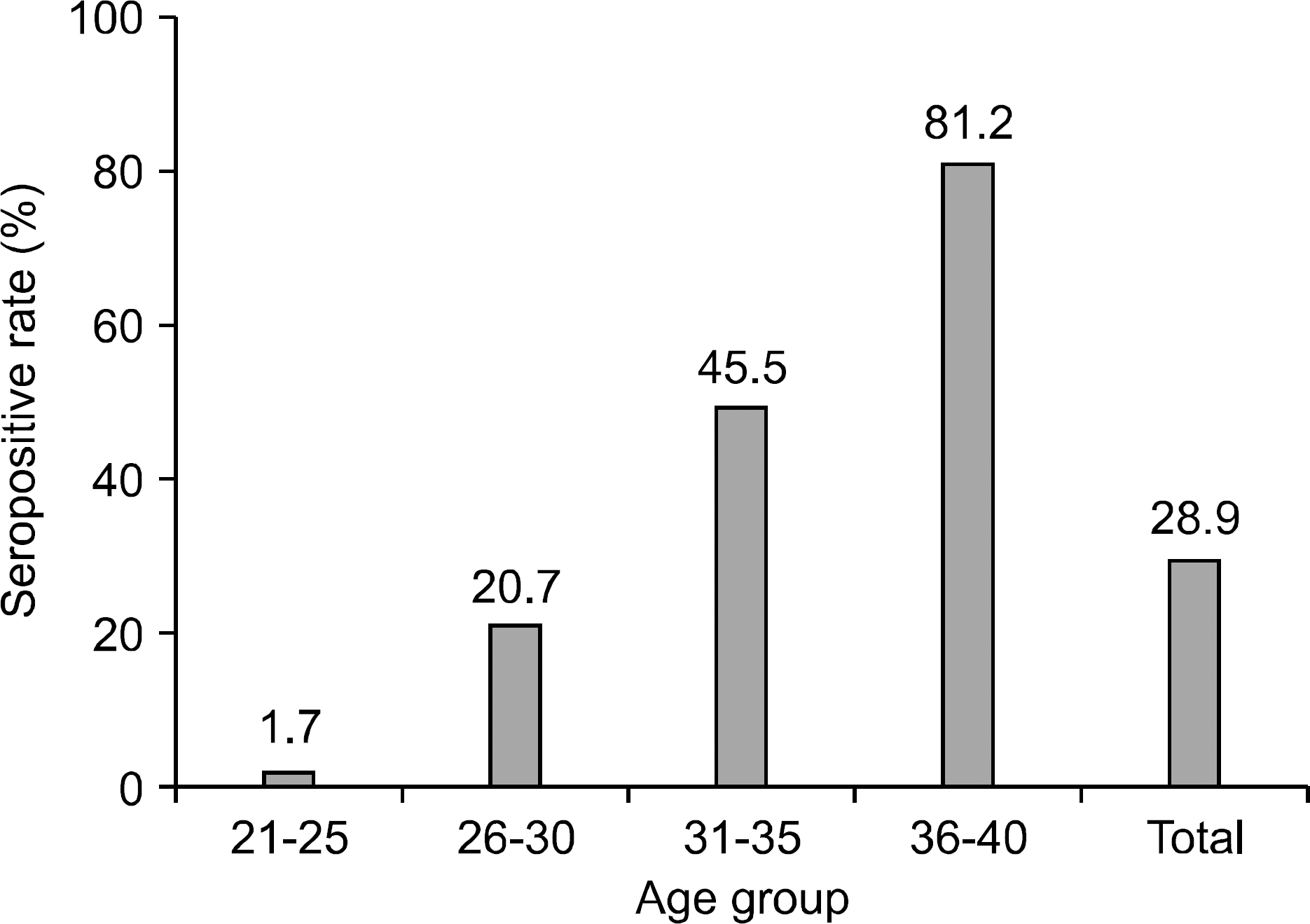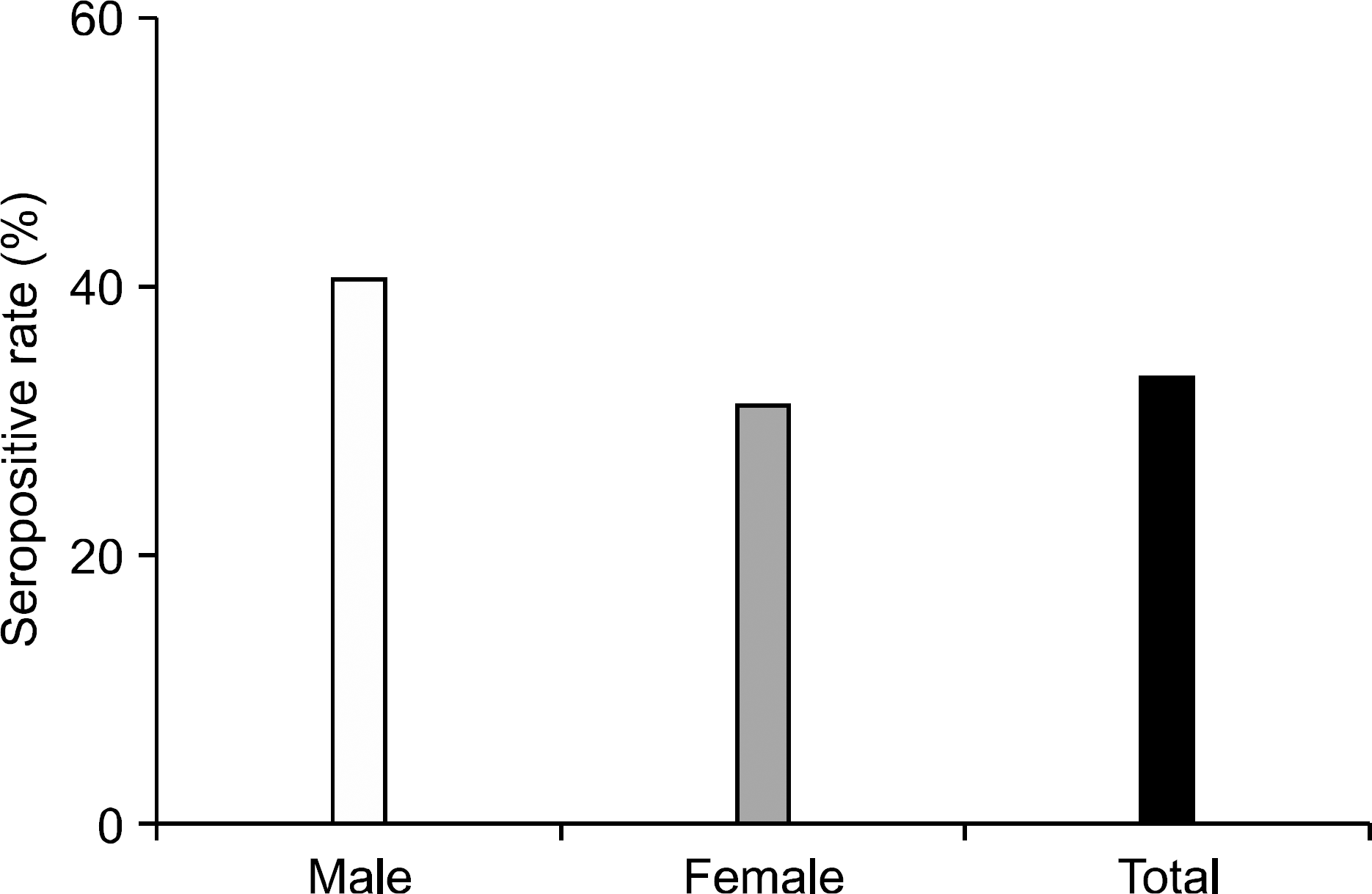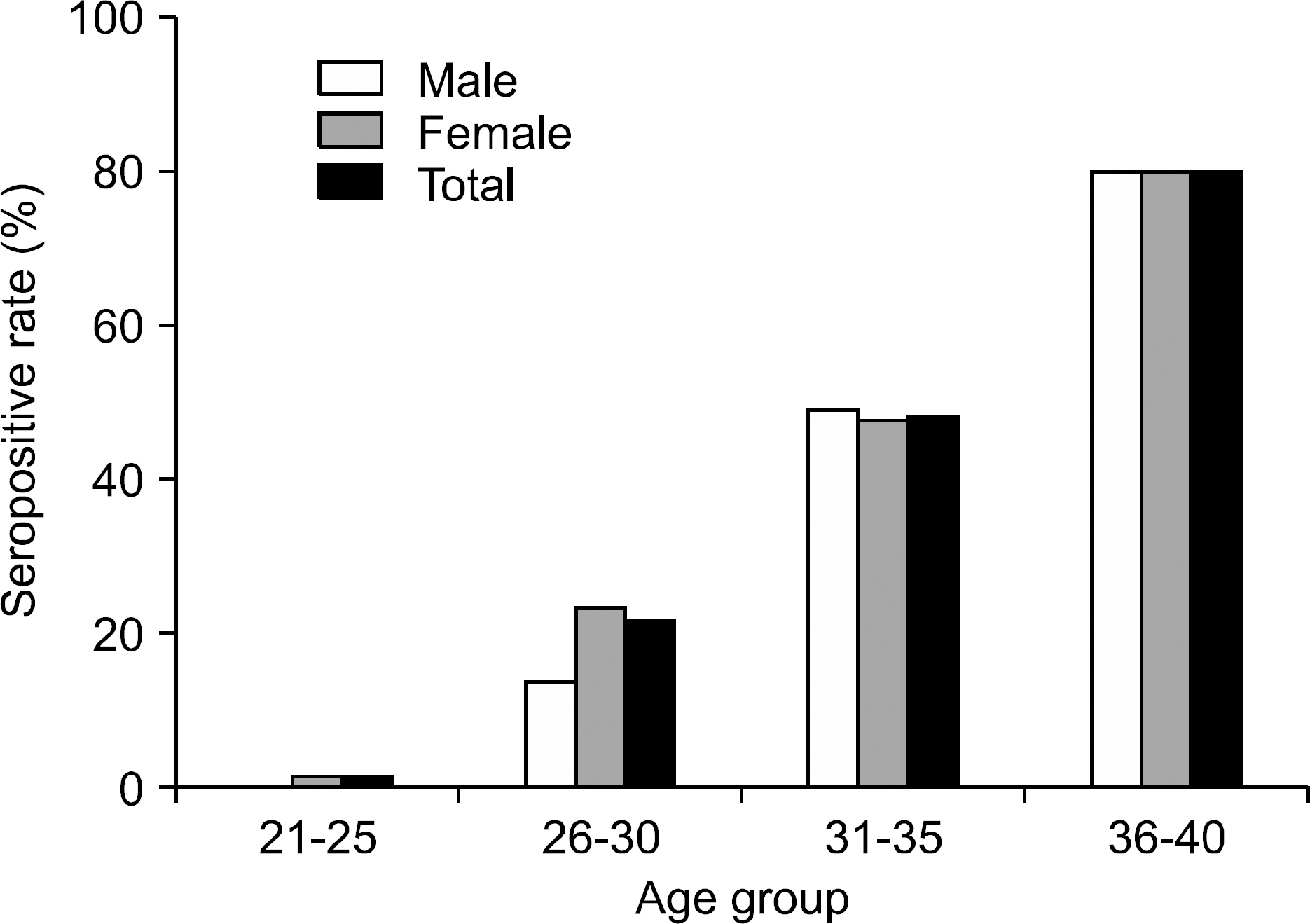Abstract
Background/Aims
Hepatitis A is an acute infectious disease transmitted by fecal-oral route. As the incidence of hepatitis A has been increased in Gwangju and Chonnam province of Korea recently, the number of hepatitis A patients in hospital employees has also increased. Thus, we investigated the seroprevalence of IgG anti-HAV in hospital employees below 40 years old.
Methods
We analysed the seroprevalence of anti-HAV IgG from 1,002 Chonnam national university hospital empolyees (men: 190, women: 812) who were below 40 years old. The age group was divided by 5 years; 21-25 years old 199 (19.9%), 26-30 years old 426 (42.5%), 31-35 years old 215 (21.5%), 36-40 years old 162 (16.1%).
Results
Overall seropositive rate of IgG anti-HAV was 32.8% (329/1,002). The seropositive rate of men was 40.5% (77/190) and that of women was 31.0% (252/812). The seropositive rates of each age group were 1.5% (3/199) in 21-25 years old, 21.6% (92/426) in 26-30 years old, 48.4% (104/215) in 31-35 years old, and 80.2% (130/162) in 36-40 years old. The seropositivity rate of the high risk group (doctors, nurses, technicians) was 28.9% (234/809).
REFERENCES
1. Feinstone SM, Kapikian AZ, Purceli RH. Hepatitis A: detection by immune electron microscopy of a virus-like antigen associated with acute illness. Science. 1973; 182:1026–1028.

2. Advisory Committee on Immunization Practices (ACIP). Fiore AE, Wasley A, Bell BP. Prevention of hepatitis A through active or passive immunization: recommendations of the Advisory Committee on Immunization Practices (ACIP). MMWR Recomm Rep. 2006; 55:1–23.
3. Gandolfo GM, Ferri GM, Conti L, et al. Prevalence of infections by hepatitis A, B, C and E viruses in two different socioeconomic groups of children from Santa cruz, Bolivia. Med Clin (Barc). 2003; 120:725–727.

4. Nelson KE. Global changes in the epidemiology of hepatitis A virus infections. Clinical Infectious Disease. 2006; 42:1151–1152.

5. Hong WS, Kim CY. Seroepidermiology of type A and type B hepatitis in seoul area. Korean J Internal Med. 1982; 25:19–26.
6. Choi W, Eom HS, Kim IH, et al. Pattern of acute hepatitis A and anti-HAV seroprevalence of Kyungin province. Korean J Gastroenterol. 1999; 34:69–75.
7. Kim NJ, Sung JK, Lee SW, et al. An outbreak of hepatitis A in Taejeon city. Korean J Gastroenterology. 1999; 34:205–212.
8. Shapiro CN, Coleman PJ, McQuillan GM, Alter MJ Margolis HS. Epidemiology of hepatitis A: seroepidemiology and risk groups in the USA. Vaccine. 1992; 10(suppl 1):S59–S62.

9. Hadler SC, Webster HM, Erben JJ, Swanson JE, Maynard JE. Hepatitis A in day-care centers. A community-wide assessment. N Engl J Med. 1980; 302:1222–1227.
10. Lednar WM, Lemon SM, Kirkpatrick JW, Redfield RR, Fields ML, Kelley PW. Frequency of illness associated with epidemic hepatitis A virus infection in adults. Am J Epidemiology. 1985; 122:226–233.
11. Sleisenger MH. Gastrointestinal and liver disease. Volume 2. 8th ed.Philadelphia: WB Saunders;2006.
12. Akriviadis EA, Redeker AG. Fulminant hepatitis A in intravenous drug users with chronic liver disease. Ann Intern Med. 1989; 110:838–839.

13. Vento S, Garofano T, Renzini C, et al. Fulminant hepatitis associated with hepatitis A virus superinfection in patients with chronic hepatitis C. N Engl J Med. 1998; 338:286–290.

14. Keeffe EB. Is hepatitis A more severe in patients with chronic hepatitis B and other chronic liver diseases? Am J Gastroenterology. 1995; 90:201–205.
15. Papaevangelou GJ, Roumeliotou-Karayannis AJ, Contoyannis PC. The risk of nosocomial hepatitis A and B virus infections from patients under care without isolation precaution. J Med Virol. 1981; 7:143–148.

16. Goodman RA, Carder CC, Allen JR, Orenstein WA, Finton RJ. Nosocomial hepatitis A transmission by an adult patient with diarrhea. Am J Med. 1982; 73:220–226.

17. Shimizu H, Takebayashi T, Goto M, Togashi T. Studies on an outbreak of hepatitis A in an institution for the mentally retarded children. Hokkaido Igaku Zasshi. 1984; 59:247–253.
18. Klein BS, Michaels JA, Rytel MW, Berg KG, Davis JP. Nosocomial hepatitis A. A multinursery outbreak in Wis-consin. JAMA. 1984; 252:2716–2721.

19. Kang CI, Choi CM, Park TS, Lee DJ, Oh MD, Choe KW. Incidence and seroprevalence of hepatitis A virus infections among young Korean soldiers. J Korean Med Sci. 2007; 22:546–548.

20. Jindal M, Rana SS, Gupta RK, Das K, Kar P. Serological study of hepatitis A virus infection amongst the students of a medical college in Delhi & evaluation of the need of vaccination. Indian J Med Res. 2002; 115:1–4.
21. Kim TY, Sohn JH, Ahn SB, et al. Comparison of recent IgG Anti-HAV prevalence between two hospitals in Seoul and Gyeonggi area. Korean J Hepatology. 2007; 13:363–369.

22. Korean society of pediatrics. Guidelines for preventive vaccination. 5th ed.Reston: Kwangmun Publishing Co.;2002.
Fig. 3.
Seroprevalence rate according to the occupations.∗ Others: pharmacists, officers in general business, janitor, dietitian, etc.

Fig. 4.
IgG anti-HAV seropositive rates of potential high risk group (doctors, nurses and technicians) according to their ages.

Table 1.
IgG Anti-HAV Seropositive Rates in the Enrolled Subjects according to the Gender
| Age (yr) | Sex (Male/Female) | Number |
|---|---|---|
| 21-25 | 8/191 | 199 (19.9%) |
| 26-30 | 72/354 | 426 (42.5%) |
| 31-35 | 69/146 | 215 (21.5%) |
| 36-40 | 41/121 | 162 (16.1%) |
| Total | 190/812 | 1,002 |
Table 2.
Comparison of Seroprevalence Rate according to the Age and Gender Distribution
Table 3.
Comparison of Seroprevalence Rate according to the Occupations
| Age (yr) | Doctor | Nurse | Technician | Others∗ | p-value |
|---|---|---|---|---|---|
| 21-25 | 0/22 (0.0%) | 3/146 (2.1%) | 0/8 (0.0%) | 0/23 (0.0%) | 0.776 |
| 26-3031-35 | 16/110 (14.5%) 19/49 (38.8%) | 57/227 (25.1%) 42/87 (48.3%) | 5/39 (12.8%) 10/20 (50.0%) | 14/50 (28.0%) 33/59 (55.9%) | 0.049 0.365 |
| 36-40 | 9/15 (60.0%) | 62/73 (84.9%) | 11/13 (84.6%) | 48/61 (78.7%) | 0.162 |
| Total | 44/196 (22.4%) | 164/533 (30.7%) | 26/80 (32.5%) | 95/193 (49.2%) | <0.001 |




 PDF
PDF ePub
ePub Citation
Citation Print
Print




 XML Download
XML Download